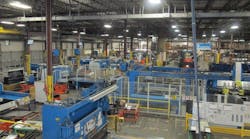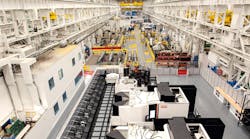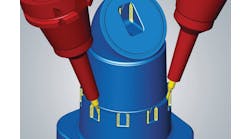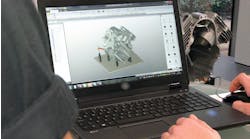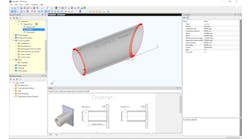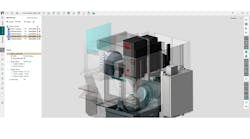Liebert Corporation manufactures air- and power-conditioning systems for computers and server rooms at three plants in Ohio, as well as a fourth in Mexico. The Emerson Electric division purchased its first Finn-Power Shear Genius right angle shearing and punching system in 1997, an installation that had Jetcam Expert CAM software installed by the vendor.
Senior manufacturing engineer Alan Mauerman explained that, “the previous CAM software was simply not designed to support right-angle shearing, and was barely acceptable for creating basic X and Y g-code for machines like our standalone Amada turret punch press. It was slow to use, often displaying unexplained errors and suffered from problems importing DXF files.
“Having the Jetcam and Finn-Power machines being supplied together proved to be a great combination as it greatly reduced our training time,” he continued. “We could make a nest and see our results quickly.”
Since Liebert adopted Jetcam it has expanded significantly, and upgraded its CNC machinery across several plants. The operation in Columbus, Ohio has six Shear Genius machines, five that are CNC punch operations, and one performing a punch/laser combination. All six have material loading robots, and most also are benefiting from right angle shearing. One of these is link to an Express Bender machine.
In fact, Jetcam drives 14 turret machines across Liebert’s plants in Columbus, Delaware, and, Ironton, Ohio, and Mexicali, Mexico.
CAD import routines had been a problem for the previous CAM software, but Jetcam's automatic “healing” routines ensure that any “unhealthy” files can be cleaned up (“healed”) automatically using pre-defined parameters. Complete directories of CAD files can be healed, imported and tooled automatically using Jetcam's Single Component Automatic Processing (SCAP) function. Then, they are immediately ready for nesting.
Moving forward Liebert and its staff have gained continuing benefits thanks to Jetcam's ease of use. They had a number of new users who had extensive shop-floor knowledge, but little computer experience. In less than a week, according to Mauerman, they had gained the confidence and skill to produce highly optimized nests.
“It's easy to use because there are only a few keystrokes required for each step,” he commented, “and what you see on the screen is what happens at the machine. There are no surprises.”
As the price of raw materials continues to rise, Liebert has engaged Jetcam to help it derive further savings. The company purchased Jetcam's high-performance nesting module, which has delivered savings on materials ranging from 5% to 13% by continuing to try different nest patterns over a specified size range. The software also includes functions like common line cutting and remnant sheet management that allow every possible square inch of material to be used, or saved for reuse where possible.
Although Jetcam provides interaction at every level Liebert wanted to automate the system as much as possible. In 2010 the company investigated automating methods for analyzing optimal sheet metal material sizes. Previously new material sizes had been based on 'educated guesses' for small runs (fewer than 30 pieces.)
“It took weeks to analyze even a small number of possibilities,” the Liebert engineer recalled, “and we simply could not analyze all of the parts for a particular material type and gage. We realized that we needed an automated method to achieve better material utilization, so we talked to Jetcam to see if they could create a solution.”
Jetcam developed a separate application using its Remote Control Processing (RCP) system to compare previous sheet sizes versus several options for new sizes. It uses the component file for each part, monthly part usage, and current sheet dimensions. Other information, like material cost, part spacing, trim width, sheet increments, and minimum/maximum size ranges, also were selected. Then, RCP automatically nests each part on all of the different sheet sizes, which takes an average 3 seconds per nest to compute. A spreadsheet is generated that compares the current cost and provides three recommended sizes based on the best weighted-average material cost savings.
“I've used RCP to analyze over 15,000 combinations of sheet sizes for just one material type. I simply could not have done that manually,” Mauerman noted.
Liebert has been using Jetcam for over 15 years, at four locations and covering many types and models of NC punching equipment. “In the past our sheet utilization was around 68-72%, but now with the RCP method coupled with high-performance nesting we have seen increases up to 13%,” he concluded.
“This has resulted in many thousands of dollars saved, and we are just getting started.”
